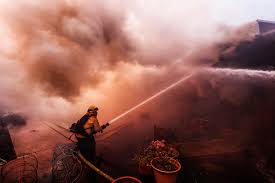
A Perfect Storm: How the Windstorm Escalated the Crisis
“California windstorm fuels Pacific Palisades wildfire and 2 others as residents flee—live updates” is not just a headline but a stark reminder of nature’s fury. The state experienced a severe windstorm with gusts exceeding 70 mph, which rapidly intensified the spread of flames in the Pacific Palisades area. The situation became critical as high winds carried embers to nearby areas, sparking additional fires and overwhelming firefighting resources.
The combination of dry conditions, unrelenting winds, and abundant vegetation created the perfect environment for wildfires to grow uncontrollably. Fire officials have stated that the “California windstorm fuels Pacific Palisades wildfire and 2 others as residents flee—live updates” scenario is one of the most challenging they have faced in recent years.
Evacuations and Community Response
As the “California windstorm fuels Pacific Palisades wildfire and 2 others as residents flee—live updates” crisis unfolds, thousands of residents have been forced to evacuate their homes. Emergency shelters have been set up to accommodate evacuees, offering temporary refuge and essential supplies. However, the emotional toll on families who have lost their homes or are unsure of their property’s fate cannot be understated.
Community organisations and volunteers have stepped in to assist, providing food, clothing, and moral support to those affected. Social media platforms have also become vital tools for sharing “California windstorm fuels Pacific Palisades wildfire and 2 others as residents flee – live updates,” ensuring real-time information reaches those in need.

The Role of Emergency Services
Firefighters and emergency responders are working tirelessly to contain the blazes. Despite the challenges posed by the windstorm, their coordinated efforts have prevented further devastation in some areas. “California windstorm fuels Pacific Palisades wildfire and 2 others as residents flee—live updates” serves as a testament to the bravery and dedication of these first responders.
State and federal agencies have deployed additional resources, including aerial water drops and bulldozers to create firebreaks. The focus remains on saving lives, protecting properties, and minimising environmental damage.
Environmental Impact of the Wildfires
The “California windstorm fuels Pacific Palisades wildfire and 2 others as residents flee—live updates” crisis is not only a human tragedy but also an environmental disaster. Thousands of acres of forest and wildlife habitats have been destroyed, and the air quality in surrounding areas has significantly deteriorated due to smoke and ash.
Scientists warn that the long-term effects of such wildfires include soil erosion, loss of biodiversity, and an increase in carbon emissions. The “California windstorm fuels Pacific Palisades wildfire and 2 others as residents flee—live updates” event underscores the need for sustainable land management and climate action to mitigate these impacts.
The Role of Climate Change
Experts agree that climate change plays a significant role in the intensity and frequency of wildfires. The “California windstorm fuels Pacific Palisades wildfire and 2 others as residents flee—live updates” scenario is a glaring example of how changing weather patterns, prolonged droughts, and extreme heat contribute to such disasters.
Governments and environmental organisations must work together to address the root causes of climate change. Investing in renewable energy, reducing carbon footprints, and implementing stricter regulations on land use are vital steps in preventing similar crises.
Lessons Learned from Previous Disasters
The “California windstorm fuels Pacific Palisades wildfire and 2 others as residents flee” situation draws parallels to past wildfires in the region. Lessons learned from previous disasters have improved evacuation protocols, emergency response times, and public awareness campaigns.
However, gaps remain in infrastructure resilience and disaster preparedness. The ongoing crisis is a call to action for policymakers to prioritise investments in fire prevention technologies, such as advanced early warning systems and fire-resistant building materials.
How Residents Can Stay Safe
For those living in wildfire-prone areas, preparedness is key. The “California windstorm fuels Pacific Palisades wildfire and 2 others as residents flee—live updates” event serves as a reminder of essential safety measures:
Create a Fire Safety Plan:
Have an evacuation plan in place and ensure all family members are aware of it.
Prepare an Emergency Kit:
Include essentials like water, non-perishable food, first aid supplies, and important documents.
Stay Informed: Follow “California windstorm fuels Pacific Palisades wildfire and 2 others as residents flee—live updates” on trusted news outlets and government channels.
Harden Your Home:
Clear debris around your property, install fire-resistant roofing, and use ember-proof vents.
Rebuilding and Recovery
As the “California windstorm fuels Pacific Palisades wildfire and 2 others as residents flee—live updates” crisis stabilises, attention will turn to rebuilding and recovery. State and federal assistance programs will provide financial aid to affected families while insurance companies work to process claims.
Communities must come together to support recovery efforts, from fundraising initiatives to volunteer-driven rebuilding projects. The resilience shown by residents during this ordeal will be crucial in overcoming the challenges ahead.
Conclusion
The “California windstorm fuels Pacific Palisades wildfire and 2 others as residents flee—live updates” crisis is a sobering reminder of nature’s unpredictability and the urgent need for preparedness. As California battles these wildfires, the bravery of first responders, the resilience of communities, and the importance of climate action come into sharp focus.
By learning from this event and taking proactive measures, we can mitigate the risks of future disasters. In 2025, let us commit to building a safer, more resilient world for ourselves and future generations. Read more







